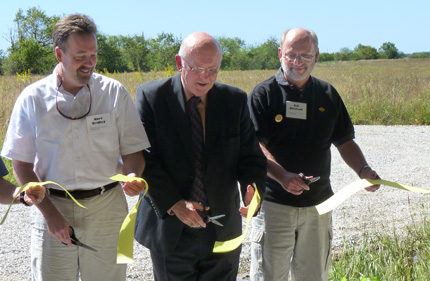Construction of the research and classroom center at the Wichita State University Biological Field Station: Ninnescah Reserve near Viola is complete. Wichita State and the Wichita State University Foundation celebrated with a ribbon cutting ceremony followed by tours of the facility and prairie, student poster presentations and ecology slide shows on Friday, Sept. 24.
The four-prong mission of the field station—research, teaching, conservation and outreach—provided the focus for the activities. Its primary function is to conduct original, environmentally based research in an undisturbed natural setting.
“The field station will not only promote increased research and types of research,” said Gary Miller, provost and vice president of academic affairs and research, “but it will also provide opportunities for collaboration with scientists at other institutions.”
Funding for the project included a $240,000 National Science Foundation grant and matching dollars from generous donors to build a research and classroom center.
The approximately half-million-dollar center serves as headquarters for three parcels of land totaling more than 500 acres: the Ninnescah Reserve, the nearby Sellers Reserve and the recently acquired Gerber Reserve in Kingman County.
“The generous support of our donors and the interest and participation of our community affirms our belief and dedication that research, teaching and public outreach regarding conservation and all aspects of science and nature are needed to preserve and restore our environment and those around us,” said Elizabeth King, president and CEO of the WSU Foundation.
Speakers participating in the grand opening included Don Beggs, WSU president; William D. Bischoff, dean, Fairmount College of Liberal Arts and Sciences; William Hendry, chairperson and professor of biological sciences; Curt Gridley, WSU alumnus; and Miller.
At each of the reserves, students and faculty study grassland restoration, river ecology and general wildlife biology. Each land parcel represents habitats west of the Flint Hills not found at field stations owned by other public universities in Kansas.
“This facility will enhance and facilitate our research and teaching efforts,” said Chris Rogers, associate professor of biological sciences and research director of the field station. “It will also provide expanded opportunities for seasonal, scheduled events such as teacher education workshops and Bioblitz, a research and surveying activity involving local high school students.”
All of these activities are strongly facilitated by the conservation of natural ecosystems and their plant and animal communities, Rogers said.


 Jillian Blackburn
Jillian Blackburn